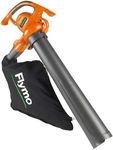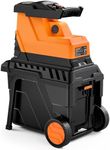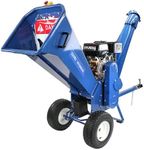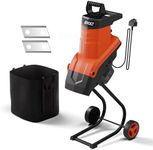Buying Guide for the Best Garden Shredders
Choosing the right garden shredder can make your gardening tasks much easier and more efficient. Garden shredders help you dispose of garden waste by cutting it into small pieces, which can then be composted or disposed of more easily. When selecting a garden shredder, it's important to consider several key specifications to ensure you get the best fit for your needs. Understanding these specs will help you make an informed decision and find a shredder that suits your garden size, the type of waste you need to process, and your personal preferences.Power SourceGarden shredders can be powered by electricity or petrol. Electric shredders are generally quieter, lighter, and easier to maintain, making them suitable for small to medium-sized gardens. They are also more environmentally friendly. Petrol shredders, on the other hand, are more powerful and can handle larger volumes of waste, including thicker branches. They are ideal for larger gardens or areas without easy access to electricity. Choose an electric shredder if you have a smaller garden and prefer a quieter, low-maintenance option. Opt for a petrol shredder if you need more power and have a larger area to cover.
Cutting MechanismThe cutting mechanism determines how the shredder processes garden waste. There are three main types: impact (or rapid) shredders, drum (or quiet) shredders, and turbine shredders. Impact shredders use fast-spinning blades to chop up waste quickly and are best for soft, green materials. Drum shredders use a slower, quieter crushing mechanism that is effective for both soft and woody materials, making them versatile and suitable for mixed waste. Turbine shredders combine the benefits of both, handling a variety of materials efficiently. Choose an impact shredder for light, green waste, a drum shredder for mixed waste, or a turbine shredder for the best of both worlds.
Shredding CapacityShredding capacity refers to the maximum diameter of branches and other materials that the shredder can handle. This is usually measured in millimeters or inches. Smaller shredders may handle branches up to 40mm (1.6 inches) in diameter, while more powerful models can handle branches up to 75mm (3 inches) or more. Consider the type and size of the waste you typically need to shred. If you mostly deal with small twigs and leaves, a lower capacity shredder will suffice. For larger branches and tougher materials, opt for a shredder with a higher capacity.
Collection Bag/BoxMany garden shredders come with a collection bag or box to catch the shredded material. This feature helps keep your work area tidy and makes it easier to transport the shredded waste to a compost bin or disposal area. The size of the collection bag or box can vary, with larger capacities allowing for longer shredding sessions without needing to empty the container frequently. If you have a large garden and expect to generate a lot of waste, look for a shredder with a larger collection capacity. For smaller gardens, a smaller collection bag or box will be sufficient.
Noise LevelGarden shredders can be quite noisy, which can be a concern if you live in a residential area or prefer a quieter working environment. Noise levels are measured in decibels (dB), with lower numbers indicating quieter operation. Electric shredders tend to be quieter than petrol models, and drum shredders are generally quieter than impact shredders. If noise is a significant concern for you, look for a shredder with a lower decibel rating. Keep in mind that quieter models may also be less powerful, so balance your need for quiet operation with the shredding power you require.
PortabilityPortability is an important factor, especially if you need to move the shredder around your garden. Consider the weight of the shredder and whether it has wheels or handles for easy transportation. Lighter, electric models are generally easier to move, while heavier petrol models may require more effort. If you have a large garden or need to move the shredder frequently, look for a model with sturdy wheels and a comfortable handle. For smaller gardens or stationary use, portability may be less of a concern.

















